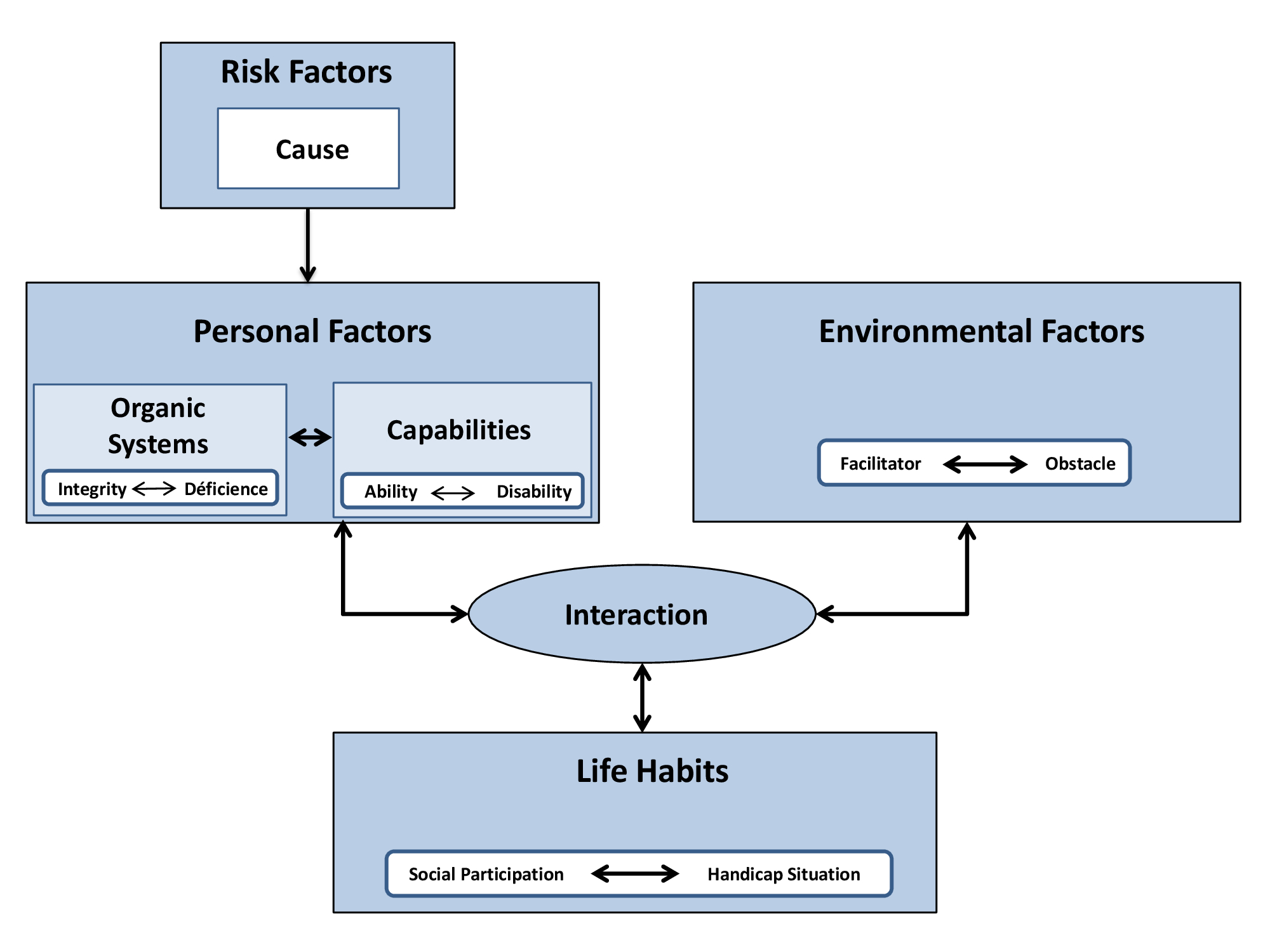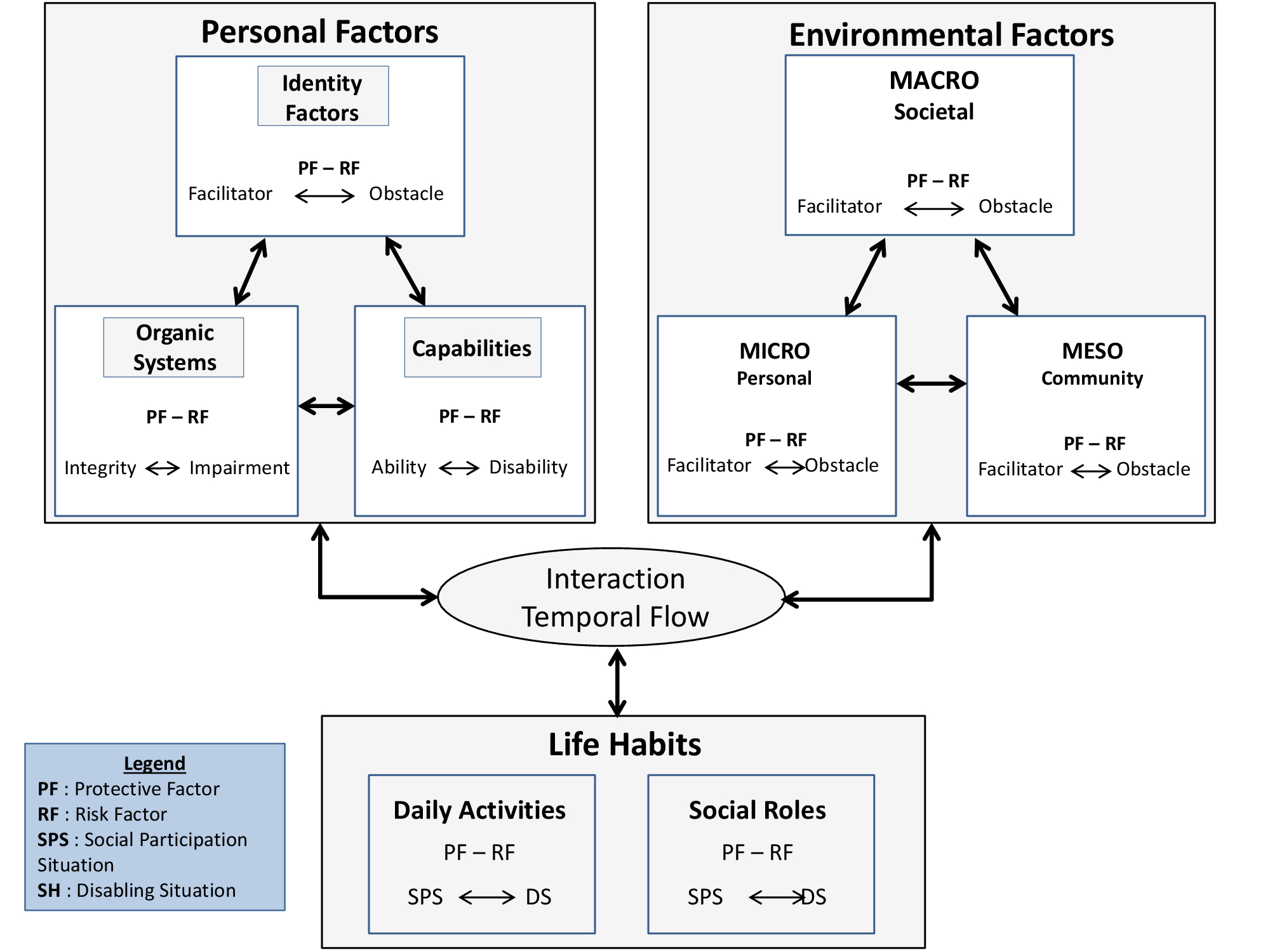The Model
The Human Development Model – Disability Creation Process (HDM-DCP) is a conceptual model which aims to document and explain the causes and consequences of diseases, trauma, and other effects on integrity and the development of the person. The HDM-DCP is designed to be used by every actor in public, parapublic, or private sectors, as well as in non-profit organizations concerned with the adaptation, rehabilitation, social participation and exercise of human rights of people with disabilities and their families.
The HDM-DCP shows that the accomplishment of life habits can be influenced by reinforcing our abilities and compensating for our disabilities through rehabilitation, but also by reducing environmental obstacles stemming. An obstacles coud be, for example, a prejudice, the lack of assistance or resources, the lack of accessibility at home and at school, a problem in obtaining adapted printed information or moving around with the help of accessible signage.
Thus, measuring the accomplishment of life habits means that we identify the result of the interaction between the person and his/her environment. Here we are referring to an indicator of the quality of social participation: It is measured over a continuum or scale ranging from an optimal situation of social participation to a complete disabling situation.
The HDM-DCP is a model that does not place the responsibility of disability on the person.
The HDM-DCP is the result of more than thirty years of international conceptual and practical work in the field of disability. Its conceptual model, definitions and nomenclature are employed by many organizations working in various areas such as education, work, health and social services, disability rights advocacy groups, public administration, etc.
The HDM-DCPconceptual model is based upon the Quebec Classification: Disability Creation Process (1998). This documentr is a scientific classification that provides definitions, taxonomies and measurement scales for life habits, environmental factors and personal factors conceptual domains. This classification system help to identify, appreciate and follow the observed changes in these three conceptual domains in a given period.
Advantages of the model
When you use the HDM-DCP as part of your professional, advocacy and research activities, you get the following benefits:
- The conceptual domains employed are positive and there is a distinction between the concepts and their qualifiers.
- Conceptualization is mutually exclusive of what belongs to the individual, the environment and life situations.
- Recognition of environmental factors as a conceptual domain.
Environmental factors, according to the HDM-DCP, constitute a conceptual area of equal importance to personal factors and life habits. Thus, it becomes impossible to deliberately conceal the impact of the living environment on the social participation of people with disabilities.
- Social participation situations and disabling situations (situations of inequality) are seen as the result of the interaction of personal and environmental factors.
Living in social participation or disabling situations is an indicatorof the level of adequacy between the environment and the characteristics of a person or a population. When disabling situations exist, it means that people’s environment does not allow them to realize their life habits or exercise their rights in the same way as the others.
- The perspective of social change aim to continually reduce systemic barriers to the enjoyment of the rights of persons with disabilities.
The advantage of an understanding of disabling situations in terms of current activities and social roles enables all concerned to better understand the nature of their responsibilities in achieving optimal social participation by those with disabilities. The dimensions of compensating for impairments and disabilities, as well as the reduction of obstacles and the establishment of environmental facilitators, therefore appear to be complementary.
How to use the HDM-DCP
The Human Development Model-Disability Creation Process(HDM-DCP) is a conceptual model designed to be used by every actors in public, parapublic, or private sectors, as well as in non-profit organizations concerned with the adaptation, rehabilitation, social participation and exercise of human rights of people with disabilities and their families. The emphasis on environmental factors and life habits of these persons makes so that it can be used for persons with disabilities as a whole, no matter the cause, the nature and the severity of their impairments and disabilities.
In the recent years, many tools were developed to facilitate the use of the HDM-DCP by the organizations, the professionals, the researchers and the activists advocating for the human rights of people with disabilities:
- Le Processus de production culturelle du handicap; Contextes sociohistoriques du développement des connaissances dans le champ des différences corporelles et fonctionnelles (1993)
- Disability Creation Process poster (1998)
- Quebec Classification : Disability Creation Process (1998)
- La funambule, le fil et la toile : Transformations réciproques dans le champ du handicap (2010)
- LIFE-H and MQE assessment tools
- HDM-DCP poster (2010)

